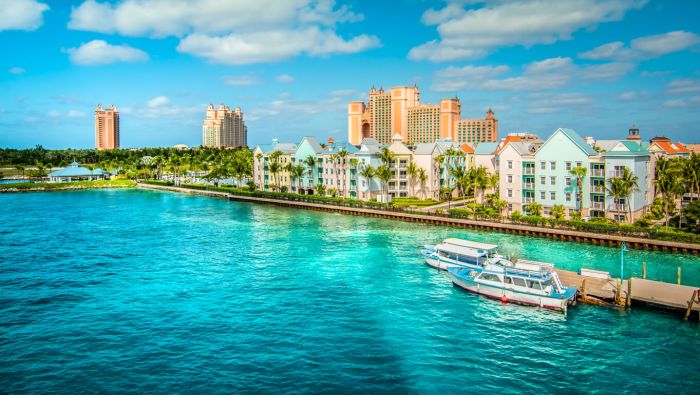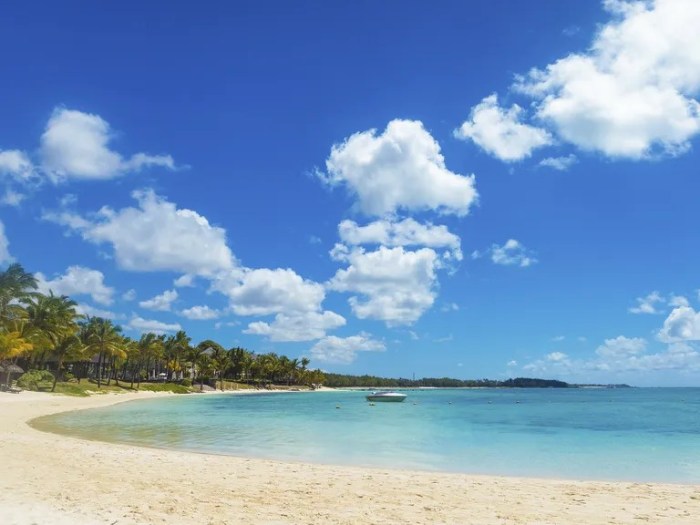Bahamas weather paints a vibrant canvas, shaping the islands’ allure and enchanting visitors with its tropical tapestry. From balmy breezes to refreshing showers, this guide unveils the intricate dance of weather patterns that define the Bahamas, inviting you to immerse yourself in its captivating embrace.
The archipelago’s unique geography and proximity to the Gulf Stream create a symphony of weather conditions, from tranquil sun-kissed days to the occasional tropical interlude. Understanding the nuances of Bahamas weather empowers travelers to plan their adventures wisely and embrace the full spectrum of experiences this paradise offers.
Current Weather Conditions: Bahamas Weather

The Bahamas is currently experiencing warm and humid weather conditions. Temperatures are hovering around 80 degrees Fahrenheit (27 degrees Celsius), with humidity levels reaching up to 80%. The wind is blowing from the east at 15 miles per hour (24 kilometers per hour). There is a 20% chance of rain today.
The Bahamas is currently under the influence of a high-pressure system that is bringing in warm and dry air from the Atlantic Ocean. This system is expected to remain in place for the next few days, so the weather is expected to remain similar.
Weather Advisories and Warnings
There are no weather advisories or warnings in effect for the Bahamas at this time.
Historical Weather Data
The Bahamas has a tropical climate, with warm temperatures year-round. The average temperature in Nassau, the capital city, is 25°C (77°F) in January and 29°C (84°F) in July. Rainfall is heaviest during the summer months, from May to October, with an average of 150 mm (6 inches) of rain per month. The Bahamas is also prone to hurricanes and tropical storms, which can cause significant damage to the islands.
Seasonal Weather Patterns, Bahamas weather
The Bahamas experiences two main seasons: a wet season and a dry season. The wet season runs from May to October, and the dry season runs from November to April. During the wet season, the Bahamas receives an average of 150 mm (6 inches) of rain per month. The dry season is much drier, with an average of only 50 mm (2 inches) of rain per month.
Extreme Weather Events
The Bahamas is prone to hurricanes and tropical storms, which can cause significant damage to the islands. The most recent major hurricane to hit the Bahamas was Hurricane Dorian, which made landfall in 2019 and caused widespread damage. Other notable hurricanes that have hit the Bahamas in recent years include Hurricane Matthew in 2016 and Hurricane Joaquin in 2015.
Climate and Geography

The Bahamas experiences a tropical climate, characterized by warm temperatures year-round and ample rainfall. The climate is primarily influenced by its proximity to the equator and the warm waters of the Atlantic Ocean.
The Bahamas is an archipelago located in the Atlantic Ocean, southeast of Florida and north of Cuba. It consists of over 700 islands and cays, with a total land area of approximately 10,000 square kilometers. The islands are generally flat and low-lying, with the highest point being Mount Alvernia on Cat Island at 63 meters above sea level.
The geography of the Bahamas plays a significant role in its weather patterns. The islands’ proximity to the equator means that they receive direct sunlight throughout the year, resulting in consistently warm temperatures. The warm waters of the Atlantic Ocean also contribute to the mild climate, as they release heat and moisture into the atmosphere.
Unique Features
The Bahamas has several unique geographical features that affect its weather. The islands are surrounded by extensive coral reefs, which act as natural barriers against strong winds and waves. Additionally, the Bahamas is located in the hurricane belt, which means that it is occasionally affected by tropical cyclones. However, the islands’ low-lying topography and relatively small size make them less susceptible to severe damage from hurricanes compared to larger landmasses.
The Bahamas enjoys warm, sunny weather year-round, with average temperatures in the mid-70s Fahrenheit. The islands are also known for their crystal-clear waters and white-sand beaches. If you’re looking for a winter getaway, consider visiting Bastogne , a historic town in Belgium that was the site of a major battle during World War II.
While the weather in Bastogne may be colder than in the Bahamas, it’s still a beautiful place to visit, with plenty of museums, monuments, and other attractions. And after a day of exploring, you can warm up with a delicious meal at one of the town’s many restaurants.
Weather Forecasting

Weather forecasting in the Bahamas utilizes a combination of advanced technology and local expertise. The Bahamas Department of Meteorology (BDM) is the primary agency responsible for providing weather forecasts and warnings for the country.
Forecasts are made using a variety of data sources, including satellite imagery, radar data, and weather station observations. Numerical weather prediction (NWP) models are also used to generate forecasts. These models use complex mathematical equations to simulate the behavior of the atmosphere and predict future weather conditions.
Accuracy of Weather Forecasts
The accuracy of weather forecasts in the Bahamas varies depending on the forecast period. Short-term forecasts (up to 3 days) are generally more accurate than long-term forecasts (more than 3 days).
There are a number of factors that can affect the accuracy of weather forecasts, including:
- The availability of data
- The complexity of the weather system
- The skill of the forecaster
Challenges and Limitations
There are a number of challenges and limitations to weather forecasting in the Bahamas. One challenge is the country’s location in the tropics. Tropical weather systems are often difficult to predict, and they can change rapidly.
The Bahamas boasts a warm and sunny climate year-round, making it an ideal destination for family vacations. With its crystal-clear waters and white-sand beaches, the Bahamas offers plenty of opportunities for swimming, snorkeling, and other water sports. In addition to its natural beauty, the Bahamas is home to a number of family-friendly resorts that offer a variety of activities and amenities for children of all ages.
From water parks and kids’ clubs to supervised activities and evening entertainment, these resorts provide a perfect balance of relaxation and fun for the whole family. And with its close proximity to the United States, the Bahamas is an easy and affordable destination for a memorable family vacation.
Another challenge is the lack of weather stations in the Bahamas. This makes it difficult to get accurate data from all parts of the country.
The Bahamas weather is tropical year-round, with warm temperatures and plenty of sunshine. However, if you’re looking for a break from the heat, you can always visit the aquarium boston , which is home to a variety of marine life from around the world.
The aquarium is a great place to learn about the ocean and its creatures, and it’s also a fun place to visit for people of all ages. After your visit to the aquarium, you can head back to the Bahamas and enjoy the beautiful weather once again.
Despite these challenges, the BDM provides accurate and timely weather forecasts for the Bahamas. These forecasts help to protect lives and property, and they support economic activities such as tourism and agriculture.
Impact of Weather on Tourism

The Bahamas’ tourism industry is heavily influenced by its weather. The islands’ warm, sunny climate attracts visitors year-round, but extreme weather events such as hurricanes and tropical storms can have a significant impact on tourism.
The weather in the Bahamas is generally predictable, with little variation in temperature throughout the year. The average temperature in Nassau, the capital, is around 28 degrees Celsius (82 degrees Fahrenheit) year-round. The islands experience two seasons: a wet season from May to October and a dry season from November to April. The wet season is characterized by frequent showers and thunderstorms, while the dry season is typically sunny and dry.
Weather Forecasting for Tourism Planning and Operations
Weather forecasting is essential for tourism planning and operations in the Bahamas. Accurate weather forecasts allow businesses to plan their operations and visitors to plan their trips accordingly. The Bahamas Meteorological Department provides regular weather forecasts and warnings, which are used by tourism businesses to make decisions about staffing, activities, and marketing.
Adapting to Different Weather Conditions
Tourism businesses in the Bahamas have adapted to the different weather conditions that the islands experience. Many hotels and resorts offer indoor activities and amenities, such as swimming pools, gyms, and restaurants, for guests to enjoy during inclement weather. Some businesses also offer discounts and promotions during the off-season to attract visitors during the wetter months.
Summary

As the sun sets on our exploration of Bahamas weather, we are left with a profound appreciation for the intricate interplay of climate, geography, and human experience. Whether seeking solace in tranquil turquoise waters or witnessing the awe-inspiring power of a passing storm, the Bahamas invites us to embrace the rhythm of nature and revel in the beauty that unfolds before our eyes.
Question & Answer Hub
What is the best time to visit the Bahamas for ideal weather?
The best time to visit the Bahamas for optimal weather conditions is during the shoulder seasons, April-May and September-October, when temperatures are pleasant, and rainfall is minimal.
Is the Bahamas prone to hurricanes?
Yes, the Bahamas is located within the Atlantic hurricane belt and is susceptible to hurricanes, particularly during the Atlantic hurricane season (June 1st – November 30th).
What is the average temperature in the Bahamas?
The average temperature in the Bahamas throughout the year is a comfortable 77°F (25°C), with little variation between seasons.